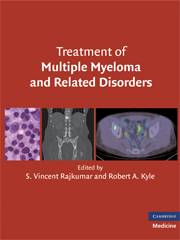Book contents
- Frontmatter
- Contents
- List of Contributors
- 1 DIAGNOSIS AND GENETIC CLASSIFICATION OF MULTIPLE MYELOMA
- 2 STAGING AND RISK-STRATIFICATION OF MULTIPLE MYELOMA
- 3 TREATMENT OF NEWLY DIAGNOSED MULTIPLE MYELOMA
- 4 MAINTENANCE THERAPY IN MULTIPLE MYELOMA
- 5 TREATMENT OF RELAPSED AND RELAPSED/REFRACTORY MULTIPLE MYELOMA
- 6 DIAGNOSIS AND TREATMENT OF MYELOMA BONE DISEASE
- 7 TREATMENT OF MYELOMA-RELATED COMPLICATIONS
- 8 AUTOLOGOUS TRANSPLANTATION FOR MULTIPLE MYELOMA
- 9 ALLOGENEIC STEM CELL TRANSPLANTATION FOR MULTIPLE MYELOMA
- 10 IMMUNOGLOBULIN LIGHT CHAIN AMYLOIDOSIS
- 11 WALDENSTRÖM MACROGLOBULINEMIA/LYMPHOPLASMACYTIC LYMPHOMA
- 12 DIAGNOSIS, RISK-STRATIFICATION, AND MANAGEMENT OF SOLITARY PLASMACYTOMA
- 13 MONOCLONAL GAMMOPATHY OF UNDETERMINED SIGNIFICANCE AND SMOLDERING MULTIPLE MYELOMA
- 14 DIAGNOSIS AND TREATMENT OF POEMS SYNDROME
- Index
- References
9 - ALLOGENEIC STEM CELL TRANSPLANTATION FOR MULTIPLE MYELOMA
Published online by Cambridge University Press: 11 July 2009
- Frontmatter
- Contents
- List of Contributors
- 1 DIAGNOSIS AND GENETIC CLASSIFICATION OF MULTIPLE MYELOMA
- 2 STAGING AND RISK-STRATIFICATION OF MULTIPLE MYELOMA
- 3 TREATMENT OF NEWLY DIAGNOSED MULTIPLE MYELOMA
- 4 MAINTENANCE THERAPY IN MULTIPLE MYELOMA
- 5 TREATMENT OF RELAPSED AND RELAPSED/REFRACTORY MULTIPLE MYELOMA
- 6 DIAGNOSIS AND TREATMENT OF MYELOMA BONE DISEASE
- 7 TREATMENT OF MYELOMA-RELATED COMPLICATIONS
- 8 AUTOLOGOUS TRANSPLANTATION FOR MULTIPLE MYELOMA
- 9 ALLOGENEIC STEM CELL TRANSPLANTATION FOR MULTIPLE MYELOMA
- 10 IMMUNOGLOBULIN LIGHT CHAIN AMYLOIDOSIS
- 11 WALDENSTRÖM MACROGLOBULINEMIA/LYMPHOPLASMACYTIC LYMPHOMA
- 12 DIAGNOSIS, RISK-STRATIFICATION, AND MANAGEMENT OF SOLITARY PLASMACYTOMA
- 13 MONOCLONAL GAMMOPATHY OF UNDETERMINED SIGNIFICANCE AND SMOLDERING MULTIPLE MYELOMA
- 14 DIAGNOSIS AND TREATMENT OF POEMS SYNDROME
- Index
- References
Summary
INTRODUCTION
The outlook for patients with multiple myeloma (MM) has greatly improved in the past decade. Before 1995, melphalan and prednisone were considered the standards of treatment since newer regimens such as vincristine, adriamycin, and dexamethasone (VAD) or vincristine, melphalan, cyclophosphamide, and prednisone (VMCP) produced faster responses but did not improve overall survival. Progress in the treatment of MM occurred when it was shown that high-dose therapy followed by autologous stem cell transplantation (ASCT) when compared to VAD could increase complete remission rates (CR), improve disease-free survival and increase overall survival. As such, ASCT has become the standard of care for many patients with MM. ASCT is, unfortunately, not curative for the vast majority of patients with MM. Furthermore, it has been shown that autologous transplants can produce survival benefits when used as part of initial therapy or later in the disease course, which means more recent studies of the timing of ASCT, when compared to conventional therapy, have shown equivalent survival since patients failing conventional therapy can eventually receive a transplant.
New insights into the biology and genetics of myeloma cells have resulted in the rapid introduction of new drugs with unique mechanisms of action. These drugs, which include thalidomide, lenalidomide, and bortezomib, have shown significant activity in MM, and when these new agents are combined with more traditional drugs, the response and complete remission rates are as high as responses achieved with ASCT.
- Type
- Chapter
- Information
- Treatment of Multiple Myeloma and Related Disorders , pp. 101 - 111Publisher: Cambridge University PressPrint publication year: 2008



